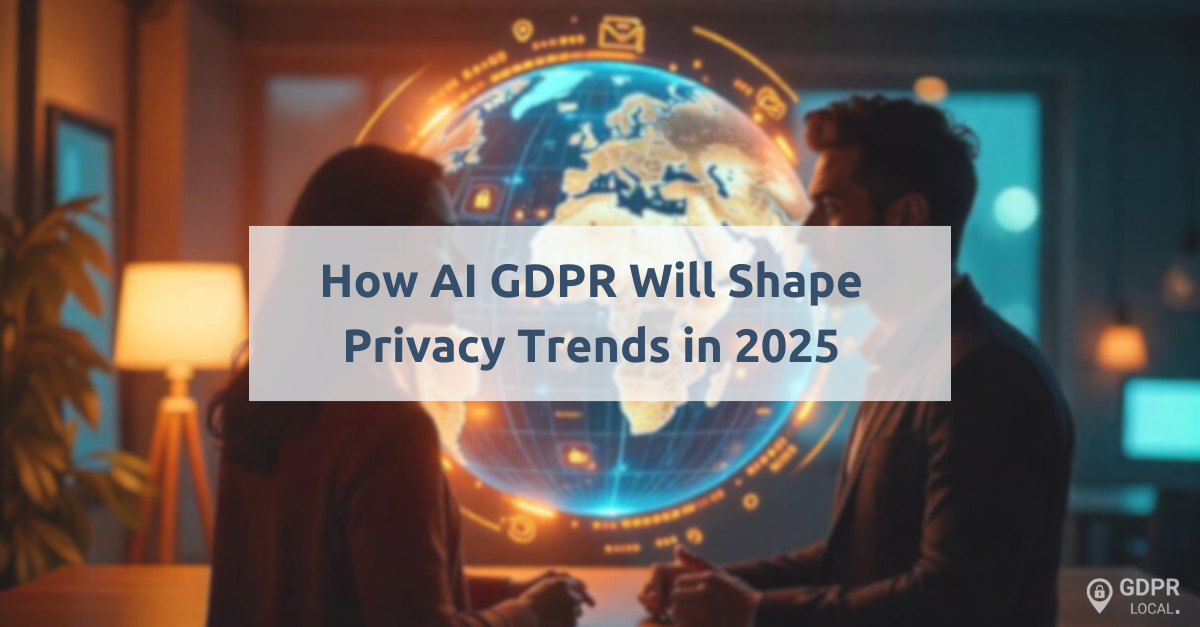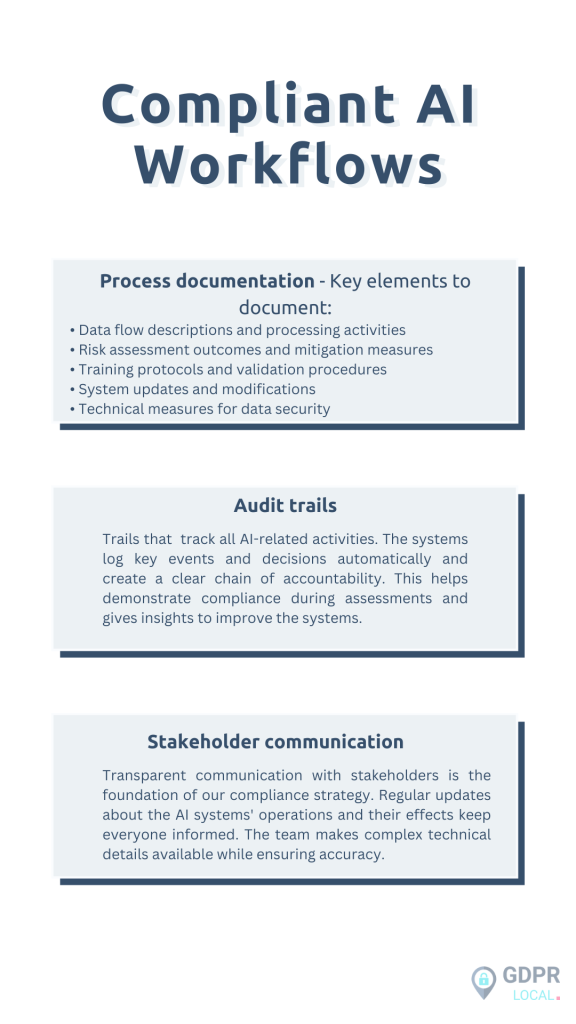
How AI GDPR Will Shape Privacy Trends in 2025
AI privacy concerns have hit record levels, and businesses worldwide are scrambling to understand how AI GDPR will alter their operations in the years ahead. Organizations now handle AI data protection differently. AI GDPR compliance and evolving privacy regulations create fresh challenges and risks that businesses don’t deal very well with.
Here is what you need to know about AI GDPR and its effects on privacy trends in 2025.
AI GDPR Requirements
Let’s get a clear picture of what makes a company compliant before we explore implementation strategies. Here’s what organizations need to think about at the time they develop and deploy AI systems under GDPR.
Key principles of AI under GDPR
Several key principles are the foundations of AI GDPR compliance:
• Data Minimization: Collecting only essential personal data needed for specific purpose [1]
• Purpose Limitation: AI systems must process data only for specified, legitimate purposes [2]
• Security and Privacy: Appropriate security measures must protect against unauthorized processing and accidental loss [1]
• Transparency: People need to know how their data plays a role in AI decision-making
Risk assessment requirements
AI systems need proper risk assessments. A Data Protection Impact Assessment (DPIA) becomes necessary if the AI processing could create high risks to people. Explanation is needed on how AI will collect, store, and use personal data. This explanation should cover both data volume and sensitivity.
Documentation obligations
GDPR places significant documentation demands on AI systems. Clear audit trails must track all data movements and storage locations [1].
These records should show:
• The purpose and legal basis for processing
• Technical documentation of AI models and their capabilities
• Risk assessment results and protection measures
High-risk AI systems need documentation that proves compliance with all relevant GDPR requirements [2]. Organizations must keep detailed processing records and put appropriate technical and organizational measures in place to protect personal data.
Implementing Privacy-First AI Systems
Privacy-first principles need practical implementation strategies that work in ground scenarios while building AI systems with GDPR compliance. Our focus remains on making these strategies work.
Data minimization strategies
A clear purpose marks the beginning of successful data minimization. AI systems should collect only what’s necessary for their intended function [4].
Several proven techniques can help achieve this goal:
• Synthetic data generation for training
• Data perturbation techniques
• Federated learning approaches
• Purpose-specific data collection
AI system development requires separation of research phase from deployment to ensure proper data handling at each stage [4].
Privacy by design approaches
Privacy by design serves as a foundation to build trustworthy AI systems. Privacy considerations must be embedded from the start of development [5]. Strong privacy safeguards and data minimization techniques need implementation while we provide transparency about our data practices [5].
A good framework from development to deployment makes privacy by design work [5]. The application level sees the greatest potential for both privacy risks and effective safeguards, so output filters and auto-delete features should be implemented here.
Automated compliance tools
Automated solutions help maintain consistent compliance. These tools monitor regulatory updates and map them to our internal policies and controls [6]. Automation proves especially effective for document reviews and audit trail maintenance [6]. The right tools can help track, react, and report on influential regulations quickly, in order to remain competitive with compliance requirements [6].
These strategies can help build AI systems that comply with GDPR and earn user trust through showed commitment to privacy protection.
Managing AI Data Protection Impact
AI GDPR compliance demands substantial financial and operational commitments. Our research reveals that organizations spend different amounts on compliance. Small to medium-sized enterprises pay £1.35 million while large enterprises invest up to £55.59 million [7].
Cost considerations
Several factors affect AI GDPR compliance costs:
• Original infrastructure setup and updates
• Data protection impact assessments
• Security measures and monitoring tools
• Documentation and audit systems
• External consulting and legal support
The investment has stabilized after the first implementation rush. Organizations still face substantial ongoing compliance costs [7]. Companies now dedicate more resources to their data strategy, which leads to better quality data for AI applications.
Resource allocation
Smart distribution of resources helps achieve AI GDPR compliance. The core team should establish proper governance mechanisms. Legal, IT, and business professionals need to work together on impact assessments [8]. This shared approach optimizes resource use and ensures detailed compliance coverage.
Training requirements
Staff training plays a vital role in any compliance strategy. Studies show that 90% of data breaches involve human error [9]. Staff awareness and education become essential parts of the process.
Training programs must cover regular sessions since these tasks need constant attention. Teams should monitor their process effectiveness and find ways to improve [9]. Companies that handle large volumes of sensitive data need a Data Protection Officer (DPO). The DPO oversees these training initiatives and maintains ongoing compliance [10].
A comprehensive approach to managing AI data protection helps handle GDPR compliance complexities while running effective AI operations.
Building Compliant AI Workflows
A solid foundation for AI GDPR compliance needs proper documentation and communication. Clear workflows help maintain consistency and accountability in AI operations.

Conclusion
This type of compliance can seem challenging, but proper planning and implementation make it manageable. A detailed approach to privacy-first AI systems with strong documentation and clear workflows helps us meet regulatory requirements and builds user trust.
Smart allocation of resources combined with automated compliance tools reduces maintenance burden. The core team needs regular training and risk assessments. Strong documentation and clear communication with stakeholders create the foundation for lasting compliance.
Organizations that adopt these privacy principles by 2025 will do more than meet regulations – they will gain an advantage through better data protection and user trust. Note that AI GDPR compliance requires continuous dedication to protect personal data while advancing artificial intelligence capabilities.
References
[1] – https://ico.org.uk/for-organizations/uk-gdpr-guidance-and-resources/artificial-intelligence/guidance-on-ai-and-data-protection/how-should-we-assess-security-and-data-minimisation-in-ai/
[2] – https://www.europarl.europa.eu/RegData/etudes/STUD/2020/641530/EPRS_STU(2020)641530_EN.pdf
[4] – https://ico.org.uk/for-organizations/uk-gdpr-guidance-and-resources/artificial-intelligence/guidance-on-ai-and-data-protection/how-do-we-ensure-lawfulness-in-ai/
[5] – https://blog.google/technology/safety-security/designing-for-privacy-in-an-ai-world/
[6] – https://www.compliance.ai/
[7] – https://www.itpro.com/security/data-protection/gdpr-costs-are-forcing-firms-to-rethink-data-strategies
[8] – https://privacymatters.dlapiper.com/2024/04/europe-the-eu-ai-acts-relationship-with-data-protection-law-key-takeaways/
[9] – https://www.itgovernance.eu/blog/en/how-much-does-gdpr-compliance-cost-in-2020
[10] – https://www.cookieyes.com/blog/gdpr-compliance-cost/
[11] – https://ico.org.uk/for-organizations/uk-gdpr-guidance-and-resources/artificial-intelligence/guidance-on-ai-and-data-protection/what-are-the-accountability-and-governance-implications-of-ai/
[12] – https://ico.org.uk/for-organizations/uk-gdpr-guidance-and-resources/artificial-intelligence/explaining-decisions-made-with-artificial-intelligence/part-3-what-explaining-ai-means-for-your-organization/documentation/